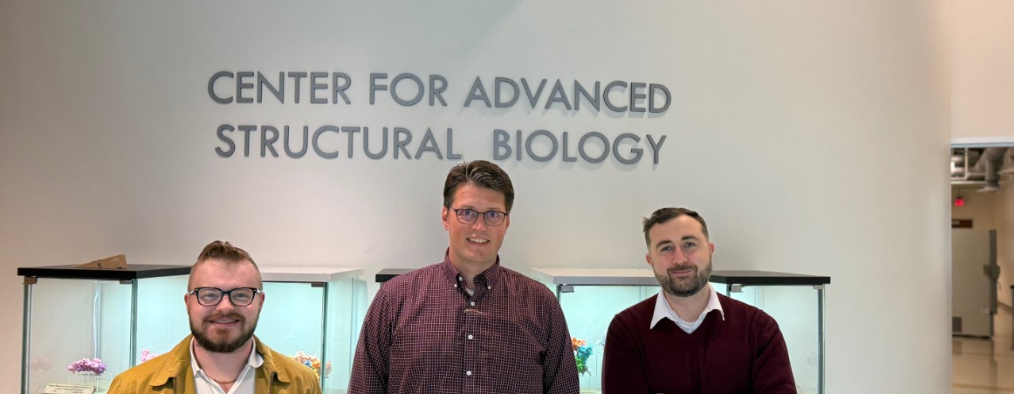Reviewed by Lexie CornerJun 16 2025
The latest technology at the University of Cincinnati’s Center for Advanced Structural Biology is allowing researchers to view two important protein structures in the body for the first time. This could support the development of improved therapies.
 Left to right: Conner Slone, Tom Seegar, Ph.D., and Joe Maciag, Ph.D., at the Center for Advanced Structural Biology within the University of Cincinnati's College of Medicine. Image Credit: Conner Slone
Left to right: Conner Slone, Tom Seegar, Ph.D., and Joe Maciag, Ph.D., at the Center for Advanced Structural Biology within the University of Cincinnati's College of Medicine. Image Credit: Conner Slone
The Proceedings of the National Academy of Sciences (PNAS) recently published findings by three structural biologists from the University of Cincinnati.
This is the first publication from the Seegar Lab at UC. Tom Seegar, Ph.D. - an Ohio Eminent Scholar and assistant professor in the Department of Molecular and Cellular Biosciences - is the study’s corresponding author.
The study’s first authors are Joe Maciag, Ph.D., a research scientist in the Seegar Lab, and Conner Slone, a graduate student assistant in the lab.
The team has mapped the atomic structure of two proteins for the first time, including how they interact. These interactions may influence protein function and contribute to inflammatory signaling.
If you can see something, you can figure out how it works. We are figuring out what this enzyme looks like and how it is regulated.
Tom Seegar, Ph.D., Study Corresponding Author, Ohio Eminent Scholar and Assistant Professor, Department of Molecular and Cellular Biosciences, University of Cincinnati
What They Saw
The Seegar Lab used cryogenic electron microscopy to examine the structure of the ADAM17 enzyme and its regulator protein, iRhom2. Their work identified key components needed for ADAM17’s function and revealed a structural link within the ADAM17-iRhom2 complex that controls how protein substrates are processed.
ADAM17 is an essential enzyme present in all cells, playing a role in cell growth and immune regulation. Its activity can become dysregulated in individuals with chronic inflammatory conditions and has been linked to diseases such as rheumatoid arthritis, cancer, and COVID-19.
The researchers are now studying the signals ADAM17 sends to other proteins involved in immune response and tissue repair.
We know in some cancers and rheumatoid arthritis, way too much signaling is occurring. But some treatments create too many side effects, worse than the disease itself.
Joe Maciag, Ph.D., Research Scientist, University of Cincinnati
Maciag said the team is exploring ways to target iRhom2 to develop more precise treatment strategies. They previously identified a structural feature called the "re-entry loop" in iRhom2, which helps transmit signals from inside the cell to the outside. This feature is essential for ADAM17 to function outside the cell. Until now, its role had not been fully understood.
Seegar highlighted the potential clinical relevance:
“This work provides a foundation for designing therapies targeting ADAM17-related diseases, offering new strategies to address critical health conditions,” he remarked.
New Research Core Facility
The ADAM17-iRhom2 complex includes the first protein structures resolved at UC’s Center for Advanced Structural Biology, which was established in 2022.
Seegar expressed, “We are indebted to UC. Our work would not be possible without this research core facility.”
Cryogenic electron microscopy has significantly advanced the field of structural biology. The center’s core equipment includes a transmission electron microscope (TEM), which allows researchers to examine complex proteins on-site at UC.
Maciag added, “It is a privilege to have this microscope in-house, and it is exciting to use it to solve these structures. It is important to our field of cellular biology and will help drive research forward and enhance our understanding of inflammation in known disease states.”
The Seegar Lab also used UC’s Advanced Research Computing Center (ARC) to store and process the cryo-EM data. This enabled them to create a 3D model of the ADAM17-iRhom2 complex on campus.
Looking ahead, the lab plans to conduct a more detailed investigation into the role of iRhom2.
These adapter proteins are not well understood. Our research will focus on understanding them and will be driven by specificity. Ideally, controlling these will enable researchers to manage disease states.
Conner E. Slone, Department of Molecular and Cellular Biosciences, University of Cincinnati
Source:
Journal reference:
Maciag, J. J., et al. (2025) Structural insights into the activation and inhibition of the ADAM17–iRhom2 complex. Proceedings of the National Academy of Sciences. doi.org/10.1073/pnas.2500732122.